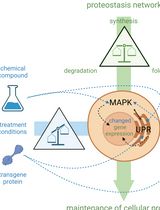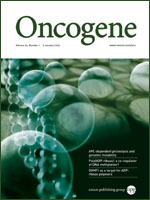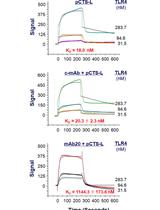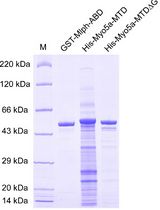- EN - English
- CN - 中文
Proximity Ligation Assay (PLA) to Detect Protein-protein Interactions in Breast Cancer Cells
邻位连接技术(PLA)检测乳腺癌细胞中蛋白质的相互作用
发布: 2015年05月20日第5卷第10期 DOI: 10.21769/BioProtoc.1479 浏览次数: 34602
评审: HongLok LungShannon RuppertAnonymous reviewer(s)

相关实验方案

Cell-Sonar:通过特定蛋白标志物表达变化追踪目标蛋白的简便低成本方法
Sabrina Brockmöller [...] Simone Rothmiller
2025年02月05日 1610 阅读
Abstract
Protein-protein interaction networks provide a global picture of cellular function and biological processes, and the dysfunction of some interactions causes many diseases, including cancer. The in situ proximity ligation assay (PLA) is a powerful technology capable of detecting the interactions among proteins in fixed tissue and cell samples. The interaction between two proteins is detected using the corresponding two primary antibodies raised in different species. Species-specific secondary antibodies (PLA probes), each with a unique short DNA strand attached to it, bind to the primary antibodies. When the PLA probes are in close proximity (<40 nm), the DNA strands can interact through a subsequent addition of two other circle-forming DNA oligonucleotides. Several-hundredfold replication of the DNA circle can occur after the amplification reaction, and a fluorescent signal is generated by labelled complementary oligonucleotide probes. Therefore, each detected signal is visualized as an individual fluorescent dot, which can be quantified and assigned to a specific subcellular location based on microscopy images. This revolutionary technique enables us to study the protein complex formation with high specificity and sensitivity compared to the other traditional methods, such as co-immunoprecipitation (Co-IP).
Materials and Reagents
- Antibody pair for detecting protein-protein interaction (two primary antibodies must have been raised in different species, e.g. rabbit-anti-EGFR from Cell Signaling Technology, catalog number: 2232 ; mouse-anti-DNA-PK from BD Pharmingen, catalog number: 556456 )
- DuolinkTM in situ reagents
- DuolinkTM in situ PLA reagents
- Duolink in situ complementary oligonucleotide probe MINUS and PLUS [5x, secondary antibody conjugated with a PLA oligonucleotide, the choice of PLA probes depends on the species of your primary antibodies: e.g. anti-rabbit PLUS (Sigma-Aldrich, catalog number: DUO82029 ); anti-mouse MINUS (Sigma-Aldrich, catalog number: DUO 92004)].
- Blocking solution (Sigma-Aldrich, catalog number: DUO82014 ): For blocking of the sample if you have not already optimized your primary antibody with another blocking solution, e.g. 2% BSA in PBS.
- Antibody diluent (Sigma-Aldrich, catalog number: DUO82015 ): For dilution of PLA probes and the primary antibodies, alternatively PBS solution with 1% BSA works as well.
- Duolink in situ complementary oligonucleotide probe MINUS and PLUS [5x, secondary antibody conjugated with a PLA oligonucleotide, the choice of PLA probes depends on the species of your primary antibodies: e.g. anti-rabbit PLUS (Sigma-Aldrich, catalog number: DUO82029 ); anti-mouse MINUS (Sigma-Aldrich, catalog number: DUO 92004)].
- Duolink detection reagents
- Ligation reagents (5x, contains oligonucleotides that hybridize to the PLA probes and all components needed for ligation except the Ligase) (Sigma-Aldrich, catalog number: DUO82016 )
- Ligase (1 unit/μl) (Sigma-Aldrich, catalog number: DUO82029)
- Amplification reagents (5x, contains all components needed for Rolling Circle Amplification except the Polymerase. Included are also oligonucleotide probes labelled with a fluorophore that hybridize to the RCA product): Containing far red fluorescently labelled oligonucleotides (Sigma-Aldrich, catalog number: DUO82019 )
- Polymerase (10 unit/μl): (Sigma-Aldrich, catalog number: DUO82030 )
The Duolink detection reagents are available to purchase as a kit from Sigma-Aldrich (e.g. catalog number for Duolink in situ Detection Reagents Far Red DUO92013 ).
- Ligation reagents (5x, contains oligonucleotides that hybridize to the PLA probes and all components needed for ligation except the Ligase) (Sigma-Aldrich, catalog number: DUO82016 )
- Duolink washing buffer A and B (see recipes)
- DuolinkTM in situ PLA reagents
- ProLong Gold antifade reagent with DAPI (Life Technologies, catalog number: P-36931), alternatively regular immunofluorescence mounting media and DAPI can be used separately.
- Reagents required for fixation and permeabilization of the sample (e.g. 3.7% fresh-made formaldehyde and 0.1% Triton X-100 diluted in PBS)
Equipment
- Fluorescence microscope equipped as follows (e.g. Leica TCS SP5 Microsystems)
- Excitation/emission filters compatible with fluorophore (ranging from 488-633 nm) and nuclear stain (ultraviolet) excitation/emission
- Camera and software for image acquisition
- Excitation/emission filters compatible with fluorophore (ranging from 488-633 nm) and nuclear stain (ultraviolet) excitation/emission
- Shaker
- Humidity chamber (moist chamber) (Figure 1)
- Freeze block for enzymes
- 37 °C incubator
- Pipettes (covering the range from 1 μl to 1,000 μl)
- Glass cover slips compatible with fluorescence microscopy (12 mm diameter and 0.13 to 0.16 mm thickness) (Optics, catalog number: 01 115 20 )
- MilliQ® or other equivalently high purity water
Software
- Duolink ImageTool software is highly recommended (Demo version for free-download: http://www.olink.com/products/duolink/downloads/duolink-image-tool). Alternatively, ImageJ or LAS AF Lite software from Leica Microsystems can be used for analysis.
Procedure
文章信息
版权信息
© 2015 The Authors; exclusive licensee Bio-protocol LLC.
如何引用
Lin, M. Z., Martin, J. L. and Baxter, R. C. (2015). Proximity Ligation Assay (PLA) to Detect Protein-protein Interactions in Breast Cancer Cells . Bio-protocol 5(10): e1479. DOI: 10.21769/BioProtoc.1479.
分类
癌症生物学 > 通用技术 > 生物化学试验 > 蛋白质分析
分子生物学 > 蛋白质 > 蛋白质-蛋白质相互作用
生物化学 > 蛋白质 > 相互作用 > 蛋白质-蛋白质相互作用
您对这篇实验方法有问题吗?
在此处发布您的问题,我们将邀请本文作者来回答。同时,我们会将您的问题发布到Bio-protocol Exchange,以便寻求社区成员的帮助。
Share
Bluesky
X
Copy link












